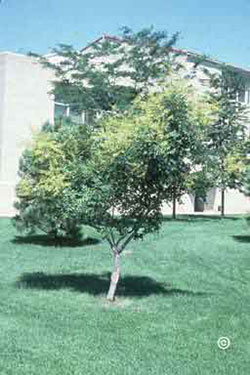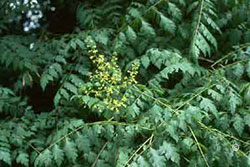
What are goldenrain trees?
Goldenrain tree, Koelreuteria paniculata, is a small- to medium-sized tree that is ideal for yards and landscapes along the Front Range because it tolerates our area’s alkaline soils. It grows at a slow to moderate rate, eventually reaching about 30 feet in height and width. The tree’s most attractive feature is its yellow flowers in July. There are few other trees and shrubs in bloom at that time, so goldenrain tree fills that void nicely.
What do these trees look like?
The tree’s flowers are followed by light green, three-sided pods that look like a Chinese paper lantern. These interesting and ornamental seed pods change from pinkish-tan to tan as they mature. The pods split open in early fall to release several pea-size, black seeds.
How is it best planted?
 While it can be attractive in a Xeriscape, if the goldenrain tree is planted in mulched or bare-soil areas, the seeds may produce unwanted seedlings. For this reason, planting a goldenrain tree in a lawn area is ideal because dense grass and mowing prevent seedling development. Goldenrain trees also make a great patio shade tree.
While it can be attractive in a Xeriscape, if the goldenrain tree is planted in mulched or bare-soil areas, the seeds may produce unwanted seedlings. For this reason, planting a goldenrain tree in a lawn area is ideal because dense grass and mowing prevent seedling development. Goldenrain trees also make a great patio shade tree.
What bugs do these trees attract?
This tree is pest-free, with one exception. Red-shouldered bugs, similar and closely related to boxelder bugs, congregate to feed on immature seeds. The bugs will not damage the tree but can be a nuisance.
Can this tree survive in high altitude?
The goldenrain tree is hardy to about 6,000 feet. It has moderately weak wood and its limbs may break under heavy snow.
For more information, see the following Colorado State University Extension fact sheet(s).



